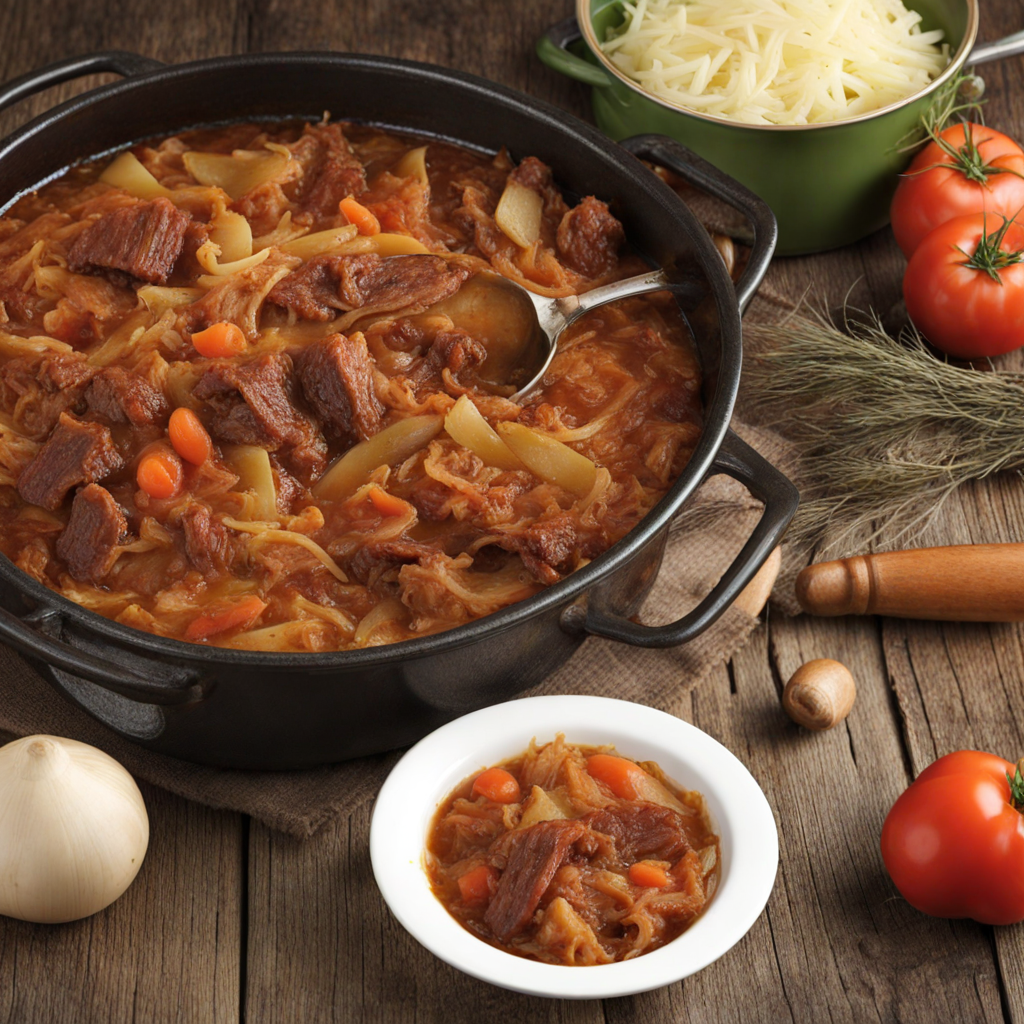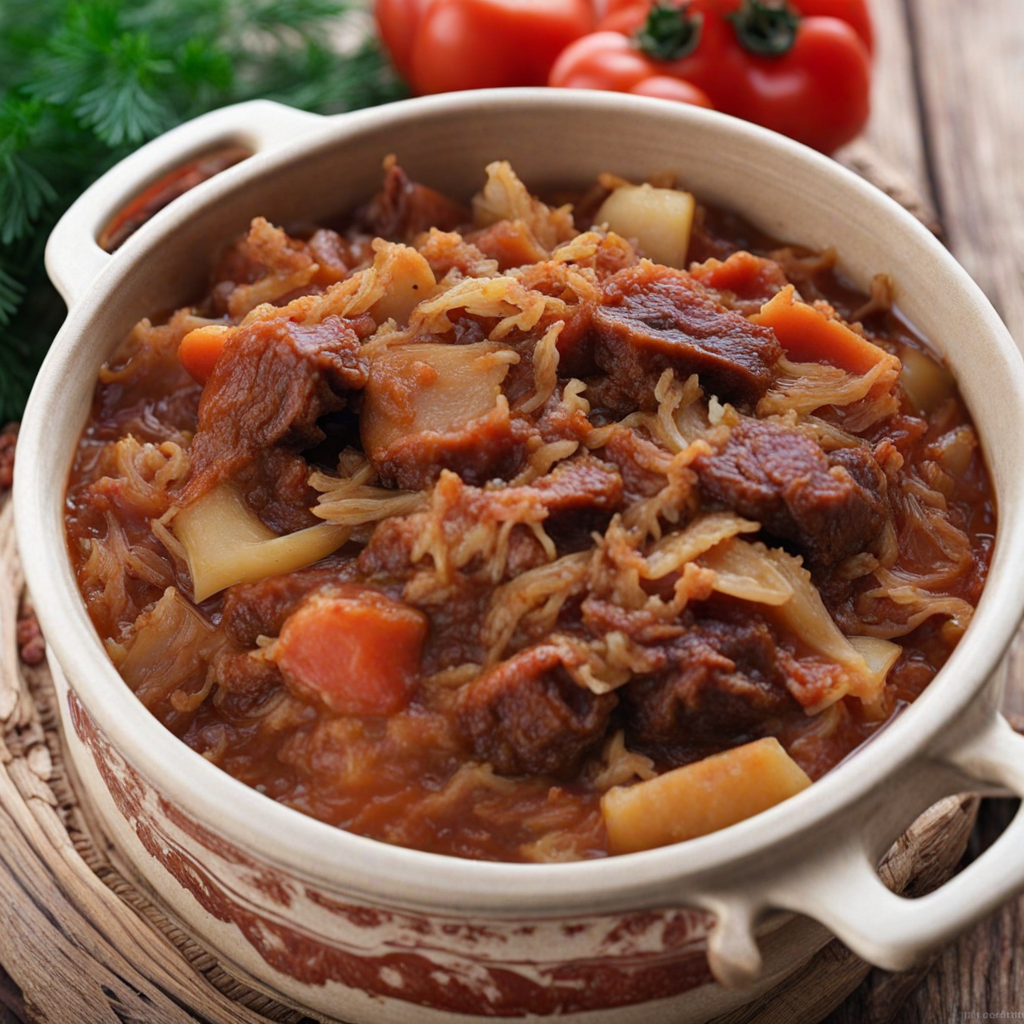Bigos
Bigos, often referred to as "hunter's stew," is a traditional Polish dish that embodies the heart and soul of Eastern European cuisine. This hearty meal is a savory mélange of sauerkraut, fresh cabbage, various types of meats, and an array of spices. The combination of ingredients varies from region to region, but it typically includes pork, beef, and sometimes game meats like venison, all simmered to perfection. The slow-cooking process allows the flavors to meld beautifully, resulting in a rich, complex taste that is both comforting and satisfying. The use of smoked meats contributes a deep, smoky essence that elevates the overall profile of this dish.
Bigos is not just a dish but a culinary tradition that reflects the seasons and celebrations of Polish life. It is often prepared in large batches, making it a staple for gatherings and family feasts. The use of sour ingredients like sauerkraut offers a delightful tang, balancing the richness of the meats. Additionally, spices such as bay leaves, allspice, and black pepper enhance its flavor, while the inclusion of prunes or dried mushrooms adds a subtle sweetness and depth. Each bite offers a journey through layers of flavor, making it a dish that resonates with both nostalgia and warmth.
How It Became This Dish
Bigos: The Polish Hunter's Stew Bigos, often referred to as "hunter's stew," is a traditional Polish dish that embodies the rich culinary heritage and cultural significance of Poland. This hearty stew has evolved over centuries, becoming a symbol of Polish hospitality and comfort food. Its origins, ingredients, cultural relevance, and evolution reflect the historical tapestry of Poland itself. #### Origins The roots of Bigos can be traced back to the medieval era, with its first mentions appearing in texts from the 14th century. The dish likely originated as a way for hunters to make use of the game they hunted, preparing it with whatever ingredients were available. The name "Bigos" itself is believed to be derived from the Polish word "bigot," which translates to "mess" or "mixture," perfectly encapsulating the stew’s nature as a combination of various meats, vegetables, and seasonings. Traditionally, Bigos was a peasant dish, made with whatever meats were available, often including game like venison, wild boar, or hare. The addition of sauerkraut, which provided a sour note and preserved the dish, illustrated the Polish penchant for fermentation and preservation, a necessity in the harsh winters of Central and Eastern Europe. Sauerkraut not only added flavor but also contributed to the dish's longevity, allowing it to be consumed over several days. #### Cultural Significance Bigos is more than just a meal; it is a symbol of Polish identity and cultural pride. The dish is often associated with family gatherings, celebrations, and national holidays, like Christmas and Easter. It embodies the spirit of hospitality, as it is often prepared in large quantities to serve extended family and friends. The preparation of Bigos is typically a communal activity, where family members come together to chop, stir, and share stories, reinforcing bonds and traditions. In Polish folklore, Bigos is often referred to as a "soul food," with its rich flavors and warming qualities providing comfort during the long, cold winters. It is said that the best Bigos is made after it has had time to rest and develop flavors, sometimes tasting even better on the second or third day. This patience mirrors the Polish approach to life, where resilience and appreciation for the simple pleasures are valued. Moreover, Bigos has secured its place in Polish literature and art. It is frequently mentioned in works by Polish authors and poets, serving as a metaphor for the complexities of life and the blending of different cultures and traditions in Poland. The dish is also celebrated in various festivals, showcasing the importance of food in Polish culture. #### Ingredients and Preparation The ingredients of Bigos can vary widely, reflecting regional differences and personal preferences. The core components typically include: - Cabbage: Both fresh cabbage and sauerkraut are often used, giving the dish its distinctive tangy flavor. - Meat: A variety of meats can be included, such as pork, beef, sausage, and game meats. Each family often has its own secret blend of meats. - Mushrooms: Dried or fresh mushrooms add an earthy depth. - Spices and Herbs: Bay leaves, black pepper, and sometimes juniper berries are used to enhance the stew's flavor. - Tomato Paste or Puree: Some recipes incorporate tomatoes for added richness. The preparation of Bigos is typically a slow-cooking process, allowing the flavors to meld. The cabbage is sautéed with meats, then simmered with broth and spices over low heat for several hours. This slow cooking not only tenderizes the ingredients but also allows the dish to develop a complex, satisfying flavor profile. #### Evolution Over Time As Poland's history unfolded, so too did Bigos. The partitions of Poland in the late 18th century led to significant regional variations. Each partitioning power—Prussia, Austria, and Russia—brought its culinary influences, showcasing the adaptability of Bigos. In the Prussian areas, for instance, the use of smoked meats became prevalent, while in the Austrian regions, the dish often included different vegetables and spices. The 20th century brought further changes, particularly during and after World War II. The hardships of war and subsequent political shifts led to variations in the ingredients used, as availability dictated what could be included in this beloved stew. Many Polish families adapted their recipes to include more accessible ingredients, leading to the "Bigos of the People," a simplified version that retained the spirit of the original while reflecting the realities of post-war life. In the modern era, Bigos has gained international recognition, often featured in Polish restaurants around the world. It has become a culinary ambassador of Polish culture, inviting non-Poles to experience the warmth and richness of Polish cuisine. As global interest in traditional foods has grown, so too has the appreciation for Bigos, with chefs experimenting with contemporary twists while still honoring its historical roots. #### Conclusion Bigos remains a quintessential dish that tells the story of Poland's past—a reflection of its landscapes, traditions, and the resilience of its people. It embodies not just a meal, but a way of life, rich in communal ties and cultural significance. The evolution of Bigos, from its humble beginnings as a hunter's stew to a beloved staple in Polish homes and restaurants, highlights the importance of food in connecting generations and preserving heritage. As you enjoy a bowl of Bigos, you are not just tasting a dish; you are partaking in a centuries-old tradition that has nourished and comforted generations of Poles. Whether savored on a cold winter night, shared at a family gathering, or celebrated at a festival, Bigos serves as a reminder of the warmth of home and the enduring spirit of Polish culture.
You may like
Discover local flavors from Poland







